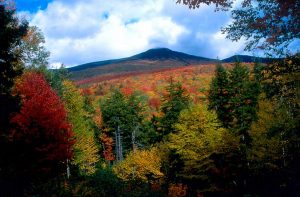The celebration of fall leaves is serious business throughout New Hampshire. With 80 percent of the state covered in oak, maple, ash and birch and an ideal combination of soil conditions and temperatures, New Hampshire’s fall colours are rivaled only by those in isolated areas of Japan.
From the last week of September to mid – October, visitors can track colour progression via a telephone hotline and website. While no one can accurately predict the north to south movement of colour that varies annually depending on temperature and rainfall, White Mountain Mikey comes close.

At the Highland Appalachian Mountain Center, a non – profit conservational and educational facility, Mike Duprey eagerly shares his knowledge of the region’s hiking trails and natural splendours. Pointing to the hardwoods surrounding nearby Elephant Head Trail, he explains that the leaves don’t really turn colour.
“When the longer fall nights stop chlorophyll production that gives the leaves their green colour in the spring and summer growing season, the yellows and oranges produced by carotenoids and the reds and purples from anthocyanins are fully visible, revealing the leaves’ true colours. Because of the heavy rainfall earlier this year”, says Mikey, “The foliage should be awesome.”
And the best place to see fall leaves?
“Franconia Notch.” He points out a yellow outcrop of rock in the distance. The Notch (mountain pass) was home to The Old Man of the Mountain, whose face, four slabs of granite precariously balanced on a fifth, “the chin”, fell off in May, 2003, the victim of rough spring weather.

But the granite state’s sorely missed mascot is not the only area attraction. Franconia Notch, bordered by the popular Flume Gorge to the south and Echo Lake to the north, provides excellent hiking, biking, fishing and swimming for visitors to Franconia Notch State Park.
The 12 kilometer stretch of I-93 between Kinsman and Franconia mountain ranges is a favorite with local outdoor enthusiasts like John Carroll, who usually advises motorists to abandon the interstate for the quieter, more scenic routes. He’s particularly fond of nearby route 2 that stretches across the state from Maine along the northern edges of the White Mountains passing through picturesque small towns.
Drivers looking for something more rugged head to Route 3 just southeast of Sherbrooke, Quebec, Kancamangus’ route to the safety of northern New Hampshire and Canada. Here, moose spotting is a guided tour option. The area is also popular with anglers and fans of New Hampshire’s signature red covered bridges. To avoid leaf peeping traffic, try the remote Highway 201, a twisty route complete with great river and lake views two hours south of Quebec City.
Previously Published in Dreamscapes Magazine
Travel Planner
- For a state wide information kit and excellent driving maps contact the New Hampshire Division of Travel and Tourism Development: visitnh.gov 1-800-386-4664
- Fall Foliage Hotline 1-800-258-3608 (During September and October only). http://foliage.visitnh.gov
- For the White Mountains map and guide go to: VisitWhiteMountains.com 1-800-FIND MTS. (1-800-346-3687)
- Forest Service Office, The White Mountain National Forest: (603) 528-8721
- New Hampshire State Parks: www.nhstateparks.org
- Accomodations: Eagle Mountain House: www.eaglemt.com 1-800-966-5779
- The Mount Washington Resort: www.mtwashington.com 1-800-258-0330
- Mountain View Grand: www.mountainviewgrand.com (603) 837-2100

